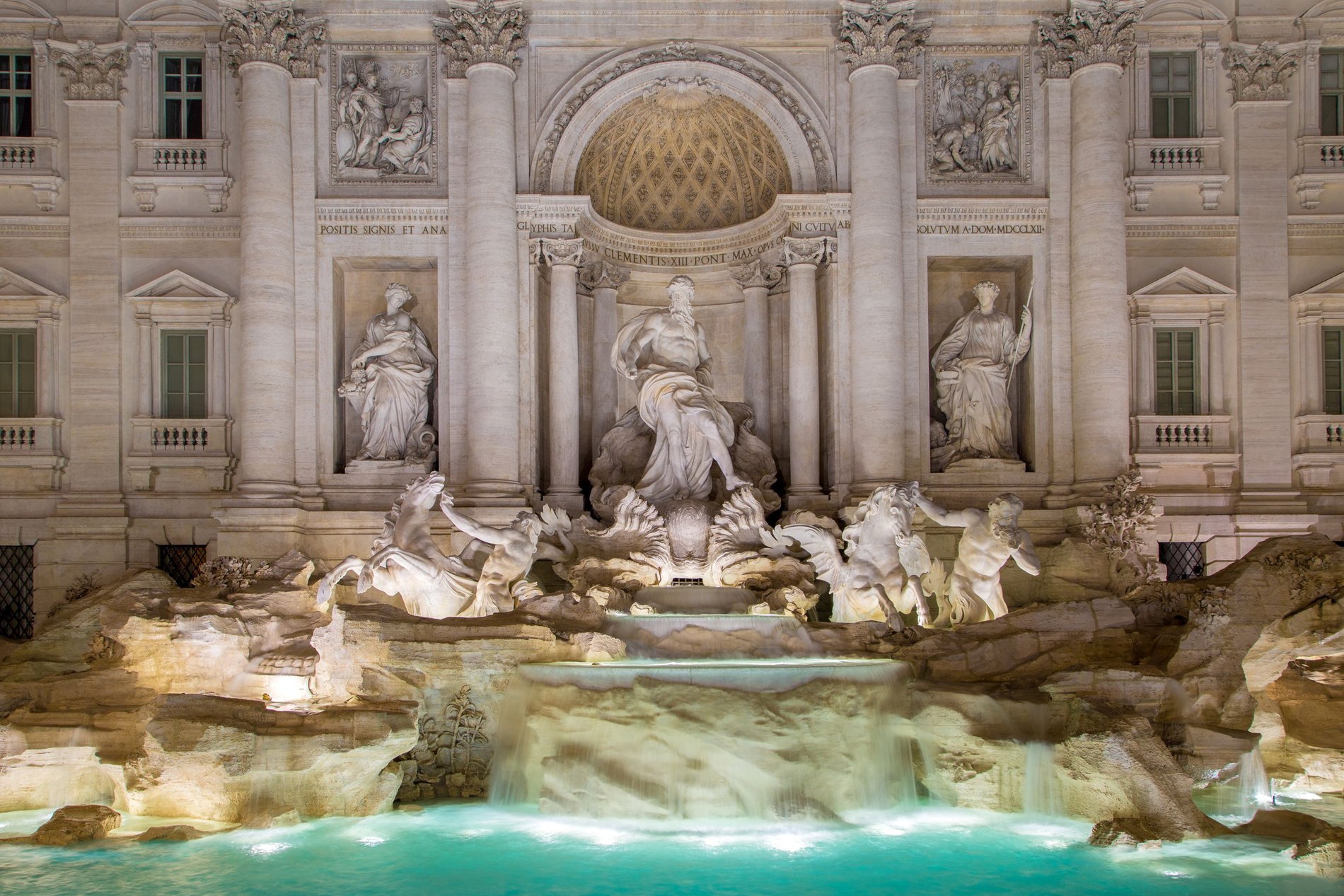Trevi Fountain
It's Rome's most famous church, and a must-see! Built at the request of Pope Clement XII, it was completed in 1762. The Trevi Fountain dates back to 1453, when it was the mouth of a Roman aqueduct that brought water from a spring built in 1453. Tradition has it that you throw 2 coins over your left shoulder into the fountain, one to make a wish, the other to make sure you get back to Rome. This fountain, the largest in the city, is located near the Pantheon. It backs onto the palace, once the residence of the Dukes Poli, now the Italian Polygraphic Institute. The arch behind it is reminiscent of the entrance to a temple. The Trevi Fountain was designed and built in honor of the god of the seas, Neptune. Measuring 20 meters wide by 26 meters high, it depicts Neptune on a chariot, drawn by two horses guided by tritons. The 9Hotel Cesàri in Via di Pietra is just a few minutes' walk from the Trevi Fountain. Take advantage of your stay at our hotel to explore the city and discover all its secrets. Whatever the reason for your stay, you're sure to find the best offer on our website!
The origins of a symbol of Rome
The origins of the Trevi Fountain date back to 1453, when the mouth of a Roman aqueduct was built to bring water from a spring located a few kilometers from the city. Over the centuries, the fountain became a meeting and gathering point for the Romans, a place to drink, wash and even pray.
The Trevi Fountain is also a place steeped in legend and tradition. According to legend, the fountain was built on the site where a young girl was said to have indicated to Roman soldiers the location of a water source. The girl was then transformed into a nymph, who would watch over the spring for eternity. This legend gave rise to a popular tradition according to which, if you throw a coin into the fountain, you're guaranteed to return to Rome one day.
When you visit the Trevi Fountain, you'll be able to admire the incredible sculptural and architectural work that went into creating it. The details are impressive, from horses and tritons to shells and other decorative elements. The fountain is a true work of art, a testament to the ingenuity and talent of the artists who created it.
The Trevi Fountain in Rome's recent history
Today, the Trevi Fountain is a symbol of the city of Rome, a must-see tourist attraction that attracts millions of visitors every year. Tradition has it that you throw two coins over your left shoulder into the fountain, one to make a wish, the other to make sure you return to Rome. The practice has become so popular that the fountain is regularly emptied to collect the coins, which are then used to fund charity projects.
But the Trevi Fountain is much more than just a tourist attraction. It is a symbol of Rome's history and Italian culture. It recalls Roman and Baroque times, legends and traditions. It embodies the beauty and grandeur of the city of Rome, a city that has inspired the greatest artists and writers in history.
The Trevi Fountain has also inspired many artists. Federico Fellini's famous film "La Dolce Vita" was filmed largely at the fountain, helping to reinforce its international reputation. Writers such as Mark Twain and Henry James have also written about the fountain, captivated by its beauty and history. In addition to artists, the Trevi Fountain has also attracted many writers and intellectuals over the years. The likes of Goethe, Stendhal and Byron have all written about the fountain, fascinated by its beauty and history. The English Romantic poet John Keats even wrote a famous poem entitled "Ode to a Nightingale" about the Trevi Fountain.
Over the years, the Trevi Fountain has become a place of celebration for Romans. Weddings, christenings and other joyous events are often celebrated around the fountain, which provides an idyllic backdrop for these special occasions.
Despite its popularity, the Trevi Fountain has also been the scene of many conflicts and controversies. Over the years, it has been the gathering place for political and social demonstrations, and the scene of many violent incidents. In 1979, a group of anti-fascist activists marched around the fountain, provoking riots with far-right groups.
Over the centuries, it has been the scene of numerous events, from political rallies to riots and popular revolts. In 2007, the fountain was at the center of a controversy when tourists were accused of stealing coins from the fountain, damaging its beauty and integrity.
The Trevi Fountain has also been at the center of debates around the preservation of Italian history and culture. In 2017, activists launched a campaign to prevent the fountain from being used as a filming location for a fashion commercial. Activists argued that the fountain was a symbol of Italian culture and should not be used for commercial purposes.
Despite these controversies, the Trevi Fountain continues to attract millions of visitors every year. Tourists can admire the fascinating details of the architecture and sculpture, toss in a coin to make a wish, or simply stroll around the area and discover the city's other treasures.
While visiting the Trevi Fountain, you can also discover the many other treasures of the city of Rome. The Pantheon, close to the fountain, is another example of Roman and Baroque architecture, with its impressive dome and columned courtyard. The Colosseum, the Roman Forum and the Vatican with its Basilica of St. Peter are other must-see attractions in the city, bearing witness to the history and grandeur of the Roman Empire.
But there's more to Rome than its monuments and history. The city is also famous for its cuisine, fashion and culture. The streets of Rome abound with restaurants serving authentic Italian cuisine, from family-run pizzerias to elegant trattorias. Fashion boutiques, art galleries and museums also offer a unique cultural experience, combining tradition and modernity.
Finally, Rome is also a lively and festive city, where cultural events and festivals take place all year round. From classical music concerts to fashion shows, film festivals and art fairs, there's always something to see and do in Rome.
The Trevi Fountain in Roman popular culture
The Trevi Fountain is also a meeting place for Romans. Locals like to gather around the fountain to refresh themselves, chat with friends or simply contemplate the beauty of the architecture. Summer evenings are particularly lively, with bands, street performers and ice-cream vendors gathering around the fountain.
The Trevi Fountain is also a place of spirituality and contemplation for many. Pilgrims and believers can meditate around the fountain and connect with their spirituality. The fountain is also a place of prayer for Catholics, who can light candles and recite prayers for their loved ones.
The Trevi Fountain is a magical place to visit when in Rome. It is a symbol of the city's history, culture and beauty. From its conception to its construction, restoration and maintenance, the Trevi Fountain embodies the very essence of the city of Rome.
Practical aspects of visiting the fountain
If you're planning a visit to the Trevi Fountain, there are a few practical aspects to bear in mind. The fountain is located in a very touristy area and can be very busy during peak hours. It is therefore advisable to visit the fountain early in the morning or late at night, when the crowds are smaller. You can also relive the cult scene from Fellini's Dolce Vita by visiting it at night.
When visiting the Trevi Fountain, be sure to observe the rules of good behavior. Avoid throwing litter into the fountain and make sure you don't disturb other visitors. Also, make sure you don't damage the fountain by climbing on it or touching the sculptures.
Finally, don't forget that the Trevi Fountain is a place of worship for many people, especially Catholics. Be sure to respect the calm and serenity of the place, even if you're not religious.
In short, the Trevi Fountain is a magical and emblematic place in Rome, embodying the city's beauty, history and culture. Whether it's tossing a coin to make a wish, admiring the Baroque architecture or enjoying the lively nightlife, the Trevi Fountain offers something for everyone. If you're planning a visit to Rome, don't miss this opportunity to discover one of the city's most precious gems.


